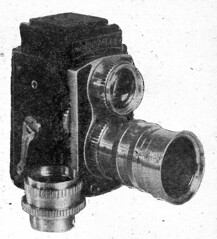Minoltaflex Automat prototypes
See also the 1937 Minoltaflex (I), the 1941 Minoltaflex Automat and the postwar Minoltaflex II and III.
The company Chiyoda Kōgaku Seikō (predecessor of Minolta) made several 6×6cm TLR prototypes in the wartime and early postwar period, to replace the Minoltaflex Automat. Three types are known, called "type A", "type B" and "type C" in the current page.[1] All have interchangeable lenses; they were certainly the first 6×6cm TLR in the world to have such feature.
Contents
Military camera
There are hints that the company made a military TLR with interchangeable lenses during World War II. This camera is only known through later documents, and no picture has been positively identified, though it is possible that the camera corresponds to the "type A" prototype (see below).
Documents from the 1940s and 1950s
The earliest document mentioning a military Minolta TLR is an article by Kitano Kunio in the June 1949 issue of Kohga Gekkan. The article shows pictures of the "type B" prototype (see below), and the author says that the camera was based on a previous model, specially made for the military during the war.[2]

|
| Chronology in Shashin Kōgyō September 1958. (Image rights) |
An official chronology published in September 1958 by Chiyoda Kōgaku Seikō mentions a "military twin-lens reflex" (軍用二眼レフ) made during the war with an interchangeable 75/3.5 lens and a Crown #1 shutter (T, B, 1–400).[3] The document shows no picture, and is known to contain mistakes about earlier Minolta models.
From the 1960s
The camera is not mentioned at all in the company's 35-year history book, published in 1963,[4] but it is described in the first Minolta camera annual (ミノルタカメラ年鑑) published the same year.[5] The document says that the camera was made in 1943; it gives a full description but shows no picture.
According to the specifications given in the document, the military TLR has semi-automatic crank advance with a red window for the first exposure only. There is a focus knob moving the front standard back and forth. The minimum distance is 0.8m, and there is a depth-of-field scale. The shutter is a self-cocking Crown-Rapid #1 (T, B, 1–400). The standard taking lens is be a Rokkor 75/3.5 (four elements in three groups, Tessar-type) closing to f/32, interchangeable with a 150/5.6. The lens mount is described as a "Leica mount" (ライカマウント), certainly a mistake. The viewing lens is a View Rokkor 75/3.2 triplet, and there is an automatic parallax correction mechanism in the viewfinder. The dimensions are 98×146×100mm[6] and the weight is a hefty 1,360g.[7] This description was written twenty years after the camera was made, and may contain mistakes. The fact that the book shows no picture of the camera, unlike other models, has been interpreted as an indication that no example was kept by the company.[8]
From the 1970s
The military camera is briefly mentioned in Minolta's 45-year history book, published in 1973. It is described as made in 1943, with a Crown-Rapid (T, B, 1–400) and a Rokkor 75/3.5, interchangeable with a 150/5.6.[9]
The 50-year history book, published in 1978, seems to be the first document to show a picture of the "type B" prototype (see below) identified as the military TLR.[10] The book says that the camera was experimented in 1943 as the "Military portable twin-lens camera" (軍用手持二眼写真機).[11] The latter name sounds like the official names given by the Japanese Army to the cameras belonging to its inventory. It is however dubious that the interchangeable-lens prototype ever received such name. It might correspond instead to the regular production models, either the original Minoltaflex or the ordinary Minoltaflex Automat: an interview of Tashima Gizō reports that the civilian "Flex" was adopted as the "portable camera type 99 or something" (99式だったか何かの手持ち写真機),[12] and Awano says elsewhere that the camera actually supplied to the military was the ordinary Automat.[13]
In the same book, a distinction is made between the military TLR, dated 1943, and another Minoltaflex Automat prototype with interchangeable lenses (ミノルタフレックスオートマット[レンズ交換][試]), dated 1948.[14] It seems likely that the authors identified the military project with the surviving "type B", and the postwar civilian projects with the surviving "type C" prototypes. After the publication of the 50-year history book, the military TLR was identified with the "type B" prototype in many later publications,[15] until an article by Awano dated August 1998 demonstrated that this identification was surely wrong.[16]
"Type A" prototype
Documents
The "type A" prototype was featured in the June 1947 issue of Kohga Gekkan as the "Minoltaflex New Automat" (ミノルタフレックス新オートマット); the magazine contains two pictures of the camera and one of the lenses.[17] The text says that the camera has a Rokkor 75/3.5 standard lens, interchangeable with a 150/6.3 via a bayonet mount.[18] The tele lens, reportedly not coupled with the viewing lens, is compared to the Magnar converter sold for the Rolleiflex,[19] though this comparison does not seem very accurate. The author did not handle the camera before writing the article,[20] and does not explain how the tele lens is supposed to be focused and framed. Rumours of further improvements are reported, such as internal flash synchronization, a built-in self-timer and even a motor-drive.[21] According to the pictures, the camera actually seems to have a built-in synch connector (see below) but maybe this went unnoticed. The author goes on saying that the camera's specifications would certainly evolve before it entered serial production, some new features being introduced and others being abandoned.[22]
The "type A" also appears in a book by Kitano Kunio on Rollei-type cameras dated August 1947.[23] The book contains one of the pictures published in June, and a different picture of the tele lens. The text says that the "Minoltaflex Automat" was "recently made with interchangeable lenses",[24] but that the "interchangeable-lens model shown here has been abandoned, and a newer product should appear soon".[25] The description mentions semi-automatic film advance with a red window for the first exposure, a Rokkor 7.5cm f/3.5 taking lens and a Konan-Rapid shutter (1–300, B).
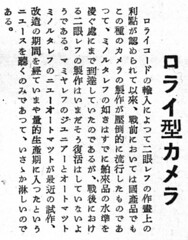
|
| Column on Rollei-type cameras in Photo Art December 1949. (Image rights) |
Finally, the same picture of the camera was reproduced in the December 1949 issue of Photo Art, in an article on Japanese cameras.[26] The quality of the reproduction, shown below, is poorer than in the June 1947 magazine. The article briefly mentions the "Minoltaflex New Automat" (ニューオートマット) among Rollei-type cameras, but does not give any specifications.

|
| Minoltaflex Automat "type A" prototype in Photo Art December 1949. (Image rights) |
Description and fate
The pictures published in Kohga Gekkan June 1947 are by far the sharpest ones. They show a massive TLR camera, larger than the regular Minoltaflex Automat and with a different body casting.[27]
There is an advance crank on the right-hand side — as seen by the photographer — together with a small window for an exposure counter, and a sliding button engaging the advance mechanism after the first exposure is positioned. The front standard moves back and forth for focusing, and a distance knob is visible on the left-hand side. There are strap lugs on the sides, identical to those of the regular Automat. The back latch is silver coloured and looks more modern.
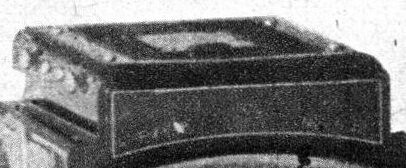
|
| Detail of the viewing hood. (Image rights) |
The viewing hood is flatter than on the Automat and certainly flips up inwards for eye-level framing. It seems that the central part flips up separately in the opposite direction, perhaps giving the correct field of view for telephoto pictures. There are lugs on the side of the hood, certainly to attach some accessory. The nameplate strangely has no marking except for the maker's name in kanji characters (千代光, Chiyokō, an abbreviation of Chiyoda Kōgaku) and No.2602 (not legible in the reproduction shown above).
The shutter appears to be located behind the front plate. There is a large speed ring rotated by an index, and the settings are legible as B, 1–300. The release button is placed at the bottom of the front standard, on the right-hand side, and is surrounded by a small ring which is perhaps a shutter lock. There is a plug on the other side, certainly for a cable release. A connector is barely visible under the viewing lens, certainly a PC socket for flash synchronization.

|
| Detail of the taking lens and surrounding controls. (Image rights) |
The markings on the viewing lens are barely legible as MINOLTAR 1:3.2 f=7.5cm. The standard lens is engraved ROKKOR 1:3.5 f=75mm TIYOKŌ No.26036, and the tele lens has 1:6.3 f=150mm TIYOKŌ, presumably with ROKKOR and a serial number too. The details of the lens mount are not visible. The rear elements of the standard lens protrude behind the mounting flange, a further indication that the shutter is recessed inside the camera. The tele lens has a sort of clamp on the side, certainly used to secure the lens on the camera. Both lenses are predominantly black with a silver ring, certainly for aperture control.
It is not known if one or several "type A" were made. No example seems to have survived, though at least one camera may still exist in a modified form as a "type C" (see below).
Relation between the "type A" and the military camera
Similar specifications
The available descriptions of the military camera are generally consistent with the pictures and descriptions of the "type A". Most features are the same, notably the moving front plate, 75/3.5 standard taking lens, 75/3.2 viewing lens and #1 shutter size. Descriptions of the advance mechanism are similar too, with a red window for the first exposure and automatic advance for the remaining frames. Furthermore, rumours of a motor-driven version in the June 1947 article might echo similar research on a military model. All these features differ from those of the "type B" camera, identified with the military camera in various publications — the above evidence indicates instead that the military camera is actually related to the "type A".
Two hypotheses
From this, two main hypotheses may be drawn: (i) the "type A" was a genuine development of the original military model, or (ii) it was an old military prototype shown to the press as a new product, while the company was working on future models.
The second hypothesis is somewhat supported by the comments in the August 1947 book, saying that the model shown was already abandoned, and by the cautious way in which the author of the June 1947 article says that the camera's features were not yet definitive.
Possible differences between the military camera and the "type A"
The only discrepancies between the specifications of the military camera found in older historical accounts and those of the "type A" are the following:
- maximal aperture of the tele lens (f/5.6 vs f/6.3);
- shutter type (Crown-Rapid to 1/400 vs Konan-Rapid to 1/300);
- viewing lens name (View Rokkor vs Minoltar);
- lens mount type (Leica mount vs bayonet mount).
Of these, the mention of a Leica mount for the military camera is implausible, and is surely a mistake. The English name "View Rokkor" also sounds dubious for a wartime military item, and may be another mistake. (The civilian Automat made at the same period has a Minolta Nippon viewing lens, and the postwar Minoltaflex II has a Minolta-Anastigmat; the name View-Rokkor would not appear until the 1954 Minoltaflex III.) The different apertures for the tele lens might correspond to different stages in the development of the camera, or alternative lens schemes.
The Crown-Rapid vs Konan-Rapid distinction might indicate that the shutter was replaced after 1945. Though the shutter name does not appear anywhere on the camera, and it is equally possible that the military camera had a #1 shutter to 1/300 from the start, only dubbed "Konan-Rapid" when the camera was shown to the press in 1947, to remind the Konan-Rapid shutter of the current Semi Minolta III instead of the "Crown-Rapid" of earlier cameras. The mention of 1/400 top speed in later descriptions of the military camera may have been inferred from the 1/400 top speed of the #1 Crown-Rapid mounted on the Auto Press Minolta.
Hints that the "type A" was made before 1945
Various details do indicate that the "type A" was developed and built at an early date. The TIYOKŌ spelling was no longer used after World War II, and was replaced by Chiyokō on the Semi Minolta III, released in 1946. The use of kanji characters (千代光) on the nameplate and the absence of a commercial name such as "Minoltaflex" or "Automat" are other strange features for a postwar civilian camera. Moreover, serial number 2602 can be interpreted as year 2602 in the old Japanese calendar used during the military period, corresponding to 1942 CE. (These details were pointed by Awano, who suggests in his August 1998 article that the "type A" is the same as the military camera.)[28]
One isolated example of the ordinary Automat has been found with similar kanji markings (千代光) and No26199 hidden under the MINOLTA AUTOMAT nameplate (see the page on the Automat).[29] The camera has a PC synch connector, placed the same as on the "type A". It is likely that this camera was part of a very late batch made for the military, with added flash synchronization, made after the interchangeable-lens "type A" was abandoned.
A further hint that the "type A" was indeed the same as the military camera is the fact that the tele lens was not properly coupled to the viewing lens for focusing. This inconvenient feature would have made the camera hardly useful as a civilian product. The inherent limitations of the design were perhaps tolerable on a military camera, whose tele lens would have been used mostly at infinity, framed through the sports finder built into the viewing hood, but certainly not for everyday use.
"Type B" prototype
Original documents
The "type B" prototype was first shown in the June 1949 issue of Kohga Gekkan, in an article by Kitano Kunio titled "Three Japanese Automat" (三つの国産オートマット), along with the Mamiyaflex Automatic and Reflex Fujica. The camera is presented as a new model of "Minoltaflex Automat" (ミノルタフレックスオートマット) that would enter production in October.[30] Mention is made that it was "developed from a camera specially built for the military during the war"[31] — surely the "type A". The article shows two pictures of the camera and tele lens, reproduced in this page. (One of these two pictures was re-used in Minolta's 50-year history book as depicting the military TLR.) The text says that the entire taking lens — including the diaphragm — is screwed in front of the shutter as on the contemporary Plaubel Makina.[32] The focusing mechanism is described as similar to the Contaflex (TLR), with a gear coupling the viewing lens to the interchangeable taking lens.[33] The article mentions the ability to take 35mm film as well as 120 film, but reports rumours that the feature would not be included in the production model — at least at the beginning.[34] It also says that some minor details, such as the advance crank, would surely be improved before the actual release.[35]
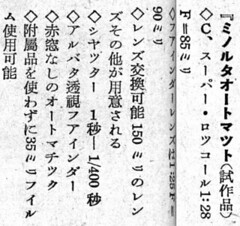
|
| Minoltaflex Automat prototype in Photo Art May 1950. (Image rights) |
The "type B" was also featured as the "Minoltaflex Automat" (ミノルタフレックスオートマット) in the August 1949 issue of the Japanese magazine Photography.[36] The column says that the camera has a Super Rokkor 85mm f/2.8 coated lens,[37] interchangeable with a coupled 150mm tele lens.[38] The viewing lens is a coated 90mm f/2.5,[39] and the shutter is merely described as a "Rapid" (1–400).[40] The text mentions an Albada finder,[41] built-in ability to use 35mm film with no additional accessory,[42] a self-cocking shutter[43] and automatic film advance with no red window.[44] The column shows one of the two pictures already displayed in Kohga Gekkan.
Finally, the May 1950 issue of Photo Art contains a description of a "Minoltaflex Automat prototype" (ミノルタフレックスオートマット[試作品]), reproduced on the right, that certainly applies to the "type B".[45] The camera has a 90/2.5 viewing lens, a C. Super Rokkor 85/2.8 taking lens interchangeable with a 150mm telephoto lens, 1–400 speeds, an Albada finder, automatic film advance with no red window, and is able to take 35mm film with no further accessory.
Description
The "type B" prototype has the classical TLR shape, but is somewhat more massive than the "type A" and "type C", themselves larger than the regular Minoltaflex and Minoltaflex Automat.[46] The exact dimensions are unknown. (The weight given in a recent source correspond to the military camera, and is certainly wrong.)[47]
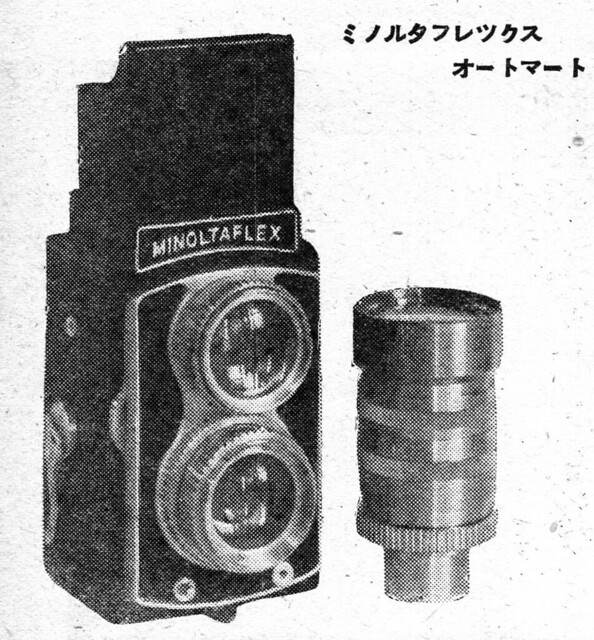
|
| Minoltaflex Automat "type B" prototype in Kohga Gekkan June 1949. (Image rights) |
Film loading, advance and viewing
The camera takes 6×6cm pictures on 120 film or 24×36mm pictures on 35mm film. There is a sprocket shaft permanently installed under the exposure chamber, and a removable reducing mask for the smaller format;[48] this was probably complemented by adapters allowing to insert 35mm film cassettes in the spool compartments. There are two film flanges on the photographer's left, which can be pulled out to insert the film rolls.
The film is advanced by a folding crank on the photographer's right, and there is a small round window for an exposure counter placed above. The internal disc placed behind the window has 0, S, two dots, then graduations from 1 to 12.[49] The film advance is coupled with the shutter cocking mechanism,[50] and it is certainly unlocked automatically when the shutter is tripped. A small button is visible on the advance side, at the top rear, certainly used to reset the exposure counter. One recent source says that the position of the first exposure is set via a red window,[51] but this is surely a confusion with the specifications of the military camera. (On the contrary, two of the original documents cited above say that the camera is fully automatic with no red window.)[44][45]
The camera is identified by a MINOLTAFLEX nameplate attached in front of the viewing hood. The latter contains a magnifying lens, hinged at the top, and a large Albada finder hidden under a cover flap.[52] It is said that this Albada finder has a frame for the 150mm tele lens.[53] (The integration of an Albada finder in the viewing hood was certainly inspired from the German Contaflex and Ikoflex III.) It is likely that the focusing screen has a frame for the tele lens too.
Focusing, shutter and lenses
The front plate is fixed and has a wheel protruding on each side. The wheel on the photographer's right drives the focusing helix of the viewing and taking lenses; that on the left selects the shutter speed.[54] The shutter is fully contained behind the front casing. Its diameter is unknown; one source showing pictures of the surviving camera mentions #0 size,[55] but this is perhaps too small to accommodate the interchangeable lenses. The range of speeds, reported as 1–400 in the original documents,[40][45] is unconfirmed. No self-timer control is visible. The selected speed is displayed in a small window at the top of the front casing, above the viewing lens.[56] The release button is at the bottom of the front casing, under the taking lens, and is actuated by the photographer's right-hand finger; there is a hole for a cable release on the opposite side.
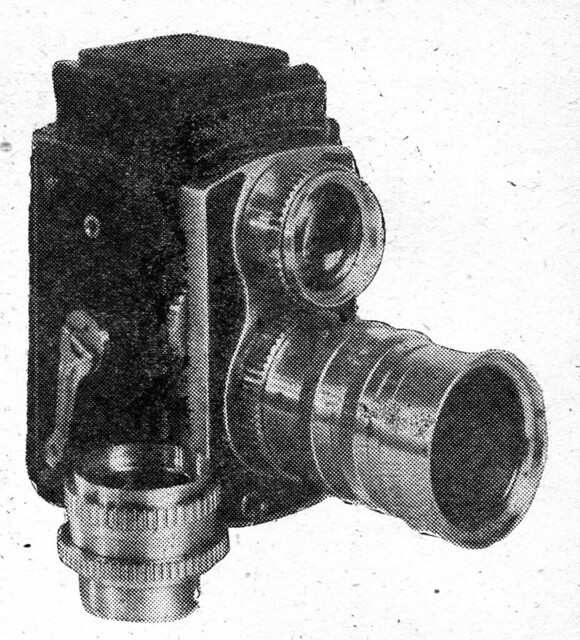
|
| Minoltaflex Automat "type B" prototype in Kohga Gekkan June 1949. (Image rights) |
According to the original documents, the viewing lens is a coated 90mm f/2.5, the standard taking lens is a coated 85mm f/2.8 and the tele lens is a 150mm.[36][45] The reported maximal apertures seem consistent with the diameter of the front elements visible in the pictures. (Recent sources mentioning the camera make a confusion with the military model and list a 75/3.2 viewing lens, 75/3.5 standard lens and 150/5.6 tele lens.)[57] The June 1949 article mentions a screw mount,[32] but its exact dimensions are unknown.[58]
The viewing and taking lenses have the same all-chrome finish with gear-like knurls, reminiscent of the lenses of the Kodak Ektra. They have no marking whatsoever, and are clearly not ready for serial production. The two taking lenses have a knurled ring at the base, serving as a grip to mount and unmount them; this ring also contains the focusing helix, at least on the standard lens, but no distance scale is visible anywhere.[59] There is a notch in the rear part of the lens, behind the mounting flange, certainly to engage a focusing cam as on the Contaflex TLR.[60] The standard lens has another knurled ring at the front, controlling the diaphragm but lacking an aperture scale. The tele lens has two rows of finer knurls at the middle of the barrel, the front of which certainly corresponds to the aperture ring. The viewing lens also contains a diaphragm controlled by a knurled ring at the front of the barrel, similar to that of the standard taking lens; again no aperture scale is visible.[61]
Incomplete surviving camera
The only pictures showing a complete "type B" model are those reproduced in this page, taken in 1949. All subsequent pictures show an incomplete camera, lacking the side plates, advance crank and tele lens.[62] At least two sets of pictures show the camera in that condition, taken with an interval of various years (in 1985 and 1988); this probably discards the hypothesis of a temporary removal of the said parts.[63]
The incomplete camera looks exactly the same as the one pictured in 1949. It seems likely that a single example was made of the "type B", which was primarily an experimental model and never reached a stable state. (Some sources give larger production estimates, but they are unrealistic.)[64]
The camera was still belonging to the Minolta company in the 1980s.[65] It was not exhibited at the 2005 Konica Minolta exhibition of the JCII, unlike other Minolta prototypes. Its current fate is unclear, as for the rest of the Konica Minolta collection.
"Type C" prototypes
Description
The "type C" model was clearly based on the "type A". The main body is the same with almost no modifications. The nameplate has an incurved shape with the Minoltaflex name, and is the same as on the 1950 Minoltaflex II. The focus knob is engraved with a dual scale: distances for the tele lens are intertwined with those for the standard lens, but the numbers are rotated so as to stand out from the others.[66]
The shutter reportedly gives B, 1–300 speeds;[67] it is sometimes reported as a Konan-Rapid[68] but this is unconfirmed and no name is visible. The speed ring has the same moving index as on the "type A". The release button is on the front plate under the shutter, on the right-hand side, and there is a thread for a cable release on the opposite side; this is the same configuration as the "type A" and "type B". The PC socket of the "type A" is replaced by an ASA synch post, located at the same place.
The "type C" has Super Rokkor 85mm f/2.8 taking and viewing lenses; this is the main difference with the "type A". The two lenses have an all chrome finish, and are engraved Chiyoko © SUPER ROKKOR 1:2.8 f=85mm No0001 or No0002. The viewing lens is fixed and has no diaphragm. The standard taking lens screws inside the shutter and has an aperture ring graduated from 2.8 to 16. The rear lens elements significantly protrude inside the camera, in front of the shutter blades.[69] No tele lens has ever been observed for the "type C", and it is not sure that it was actually built.
Surviving examples
The "type C" was not featured in any original document found so far. Two examples are known; both were still existing in the 1980s or 1990s. One was owned by Awano Mikio and the other was presumably property of the Minolta company. Their current fate is unknown.
The first camera has serial no.0001 on the taking and viewing lenses. Its viewing hood is simpler than that of the "type A": it can be used as a sports finder for the standard lens but has no additional hinged part at the centre for the tele lens. The release button is missing in older pictures of the camera, taken in the 1970s or 1980s, leaving a hole with a cam visible inside,[70] and sometimes an accessory release is plugged into the cable thread.[71] Later pictures of the same camera, taken in 1998, show a release button;[72] the part is different from that fitting the other camera, and is perhaps not original.
The second camera has serial no.0002 on the two lenses. The central part of the viewing hood is hinged outwards, as on the "type A", to frame the telephoto lens. This part has a Chiyokō logo in kanji characters (千代光), a type of logo that was used in the wartime period and looks outdated on this camera. The camera has the same release button and cable release socket as the "type A".
Relation with the other models
It is very likely that the second example of the "type C" was originally a "type A" — hence the anachronistic kanji logo — that was refurbished in the late 1940s, by fitting newer lenses, a simpler lens mount and an ASA synch post. (ASA connectors were favoured in Japan at the time, until they went out of fashion around 1955.) The first camera was perhaps a modified "type A" too but the case is less clear.
The Minoltaflex nameplate of the "type C" — identical to that of the Minoltaflex II — and the ASA synch post hint that the camera was made c.1950.[73] The camera was probably developed as an alternative to the "type B", that would have made a great camera but was probably too costly to produce. It was less refined and would probably have made a lesser impression; this is certainly why it was not shown to the public.
As already mentioned for the "type A", the fact there was no way to couple a telephoto lens with the viewing lens would have been a major inconvenient. It is possible that at the time the "type C" was developed, the concept of a telephoto lens was dropped, and that the ability to remove the taking lens was merely kept for continuity reasons. A hint of this is the absence of the frame finder for the telephoto lens on the first camera, and of course the non-existence of a tele lens specifically made for that model. (It is probable that the focus knob with dual scale was inherited from the "type A", as was the tele frame finder with kanji logo on the second camera.)
Notes
- ↑ This naming convention was introduced by Awano in Camera Collectors' News no.254.
- ↑ Kitano, p.49 of Kohga Gekkan June 1949: 戦時中軍用機として特に製作したものから発展したタイプで[...].
- ↑ "Hensen kamera ichiran-pyō", p.295 of Shashin Kōgyō no.77 (reproduced in this Flickr page by Rebollo_fr).
- ↑ 35-nen no ayumi.
- ↑ Extract of Minoruta kamera nenkan reproduced in Awano, p.4 of Camera Collectors' News no.254.
- ↑ The dimensions are wrongly repeated as 198×146×100mm in Scheibel, p.29, and the weight is confirmed in Tanimura, p.26 of Kurashikku Kamera Senka no.12.
- ↑ The weight is repeated in Scheibel, p.29, and in Tanimura, p.26 of Kurashikku Kamera Senka no.12 (wrongly associated to the "type B" model).
- ↑ Awano, pp.2–3 of Camera Collectors' News no.254.
- ↑ 45-nen no ayumi, p.89.
- ↑ Minolta 50-nen no ayumi, p.7.
- ↑ Minolta 50-nen no ayumi, p.6.
- ↑ Tashima Gizō, interviewed by Saeki Kakugorō on p.78 of Kurashikku Kamera Senka no.12.
- ↑ Awano, p.17 of Kurashikku Kamera Senka no.12.
- ↑ Minolta 50-nen no ayumi, p.65.
- ↑ "Minoruta no gun'yō kamera", p.18 of Kurashikku Kamera Senka no.12; Tanaka, p.26 of the same; "Minolta Camera: Shisaku kamera", p.60 of the same; Sugiyama, item 2015; Francesch, pp.88–9.
- ↑ Awano, Camera Collectors' News no.254.
- ↑ Column in Kohga Gekkan June 1947, reproduced in Awano, pp.5–6 of Camera Collectors' News no.254.
- ↑ Column in Kohga Gekkan June 1947, reproduced in Awano, pp.5–6 of Camera Collectors' News no.254: 標準レンズは三・五のロッコール七十五ミリで、交換用レンズは同じく一五〇ミリ、六・三のレンズである。交換はバヨネットによる。
- ↑ Column in Kohga Gekkan June 1947, reproduced in Awano, pp.5–6 of Camera Collectors' News no.254: 百五十ミリは望遠設計になるもので、上下レンズは連動しない点はロライの望遠用補助レンズマグナーと同様である.
- ↑ Column in Kohga Gekkan June 1947, reproduced in Awano, pp.5–6 of Camera Collectors' News no.254: ミノルタフレックスについては実際に使用して後更に詳細かをお伝えしよう.
- ↑ Column in Kohga Gekkan June 1947, reproduced in Awano, pp.5–6 of Camera Collectors' News no.254: 仄聞するところではミノルタフレックスは連続撮影用のモーターなど、この他いろいろの考案を設計製作しているとのことであり、更に新時代のカメラとして特徴の中に加えらるべきシンクロフラッシュとかセルフタイマーの類も内部加工によって取付ける方法が完成しているそうである.
- ↑ Column in Kohga Gekkan June 1947, reproduced in Awano, pp.5–6 of Camera Collectors' News no.254: 商品化するまでには上記の幾つかが整理されることになるかもしれないし、或いは又幾つかの特徴が加わるかもしれない[...].
- ↑ Extract of Rorai-gata kamera, reproduced in Awano, p.7 of Camera Collectors' News no.254.
- ↑ Extract of Rorai-gata kamera, reproduced in Awano, p.7 of Camera Collectors' News no.254: 新しく、レンズ交換型も作られているが、これまでのものは交換出来ない.
- ↑ Extract of Rorai-gata kamera, reproduced in Awano, p.7 of Camera Collectors' News no.254: ここに示した”交換型”は製造中止で、近くこれ以上の新鋭機が生れる筈である.
- ↑ Column in Photo Art December 1949, p.41.
- ↑ The body castings of the "type A" and "type C" are certainly the same, and pictures in Camera Collectors' News no.254 showing the "type C" along with a regular Automat reveal that the latter is smaller.
- ↑ Awano, p.2 of Camera Collectors' News no.254: 少し合わない点もありますが、私はこのタイプAが軍用カメラであると思います.
- ↑ Camera pictured in Mieno and Awano, pp.5–9 of Camera Collectors' News no.26.
- ↑ Kitano, p.49 of Kohga Gekkan June 1949: 新しく登場したのが、オートマット三種、即ち、マミヤフレックス、ミノルタフレックス、レフレックス・フジカであり、マミヤフレックスは発売中、ミノルタフレックスは十月頃、レフレックス・フジカは明春発売予定の最高級品である.
- ↑ Kitano, p.51 of Kohga Gekkan June 1949: 戦争中軍用機として特に製作したものから発展したタイプで[...].
- ↑ 32.0 32.1 Kitano, p.51 of Kohga Gekkan June 1949: レンズシャッターを中間シャッターとせず、マキナの如くビハインドシャッターとして用い、全鏡玉を絞共シャッターの前方にスクルーインして使用し[...].
- ↑ Kitano, p.51 of Kohga Gekkan June 1949: 上下レンズの噛合をアイドルギヤによって進退させて焦準する形式を採用しているので、コンタフレックス同様にレンズ交換が出来る.
- ↑ Kitano, p.51 of Kohga Gekkan June 1949: なおこのカメラには三十五ミリフィルムの装置が内蔵されていて、ブローニーフィルムからライカフィルムに変えて使用する場合に便利であるが、最初の市販品には省略されることになろうとも言われている.
- ↑ Kitano, p.51 of Kohga Gekkan June 1949: 掲載の写真は試作品で、ハンドルとか、その他の意匠も可成り良くなると思う.
- ↑ 36.0 36.1 Column in Photography August 1949, reproduced in Awano, p.9 of Camera Collectors' News no.254.
- ↑ Column in Photography August 1949, reproduced in Awano, p.9 of Camera Collectors' News no.254: レンズはスーパー・ロッコールF2.8 85mmコーテッド付.
- ↑ Column in Photography August 1949, reproduced in Awano, p.9 of Camera Collectors' News no.254: レンズ交換可能150mm連動望遠レンズ付.
- ↑ Column in Photography August 1949, reproduced in Awano, p.9 of Camera Collectors' News no.254: ファインダー・レンズはF2.5 90mmコーテッド.
- ↑ 40.0 40.1 Column in Photography August 1949, reproduced in Awano, p.9 of Camera Collectors' News no.254: ラピッドシャッター1秒–1/400秒.
- ↑ Column in Photography August 1949, reproduced in Awano, p.9 of Camera Collectors' News no.254: アルバダ透視ファインダー.
- ↑ Column in Photography August 1949, reproduced in Awano, p.9 of Camera Collectors' News no.254: 付属品を使用せず35mmフィルム使用可能.
- ↑ Column in Photography August 1949, reproduced in Awano, p.9 of Camera Collectors' News no.254: フィルムを捲けばシャッターがセットされる.
- ↑ 44.0 44.1 Column in Photography August 1949, reproduced in Awano, p.9 of Camera Collectors' News no.254: 赤窓を使用せず自動ストップ式.
- ↑ 45.0 45.1 45.2 45.3 Column in Photo Art May 1950, p.43.
- ↑ See the picture in Awano, p.17 of Kurashikku Kamera Senka no.12, showing the "type B" prototype together with a "type C" and a regular Minoltaflex Automat.
- ↑ Weight of 1,360g given in Tanimura, p.26 of Kurashikku Kamera Senka no.12, identical to the military camera described in the 1963 Minolta Camera Annual.
- ↑ Picture and caption on p.18 of Kurashikku Kamera Senka no.12.
- ↑ Pictures on p.18 of Kurashikku Kamera Senka no.12.
- ↑ Tanimura, p.26 of Kurashikku Kamera Senka no.12. One of the pictures on p.18 of the same magazine shows the internal coupling cam.
- ↑ Tanimura, p.26 of Kurashikku Kamera Senka no.12.
- ↑ Picture and caption on p.18 of Kurashikku Kamera Senka no.12; "Minolta Camera: Shisaku kamera", p.60 of the same.
- ↑ Tanimura, p.26 of Kurashikku Kamera Senka no.12; Sugiyama, item 2015.
- ↑ Controls are described on pp.18 and 60 of Kurashikku Kamera Senka no.12.
- ↑ #0 size: caption on p.18 of Kurashikku Kamera Senka no.12. #1 size is mentioned in Tanimura, p.26 of the same magazine, but the article by Tanimura is based on the specifications of the military camera, and is generally inaccurate on the "type B".
- ↑ Caption on p.18 of Kurashikku Kamera Senka no.12.
- ↑ 75/3.5 standard lens: Tanimura, p.26 of Kurashikku Kamera Senka no.12; "Minolta Camera: Shisaku kamera", p.60 of the same; Sugiyama, item 2015; Francesch, p.89 (105/5.6 instead of 150/5.6). — 150/5.6 tele lens: Tanimura, p.26 of Kurashikku Kamera Senka no.12; Sugiyama, item 2015; Francesch, p.89 (105/5.6 instead of 150/5.6). — 75/3.2 viewing lens: Tanimura, p.26 of Kurashikku Kamera Senka no.12.
- ↑ The mention of a Leica screw mount in Tanimura, p.26 of Kurashikku Kamera Senka no.12, is a confusion with the features of the military camera reported in the 1963 Minolta Camera Annual.
- ↑ Focusing helix: picture and caption on p.18 of Kurashikku Kamera Senka no.12.
- ↑ See the pictures of Contaflex lenses in this page at Pacific Rim.
- ↑ Pictures and captions on p.18 of Kurashikku Kamera Senka no.12.
- ↑ Pictures in Francesch, p.89, Sugiyama, item 2015, and on pp.17, 18 and 26 of Kurashikku Kamera Senka no.12.
- ↑ The pictures published in Francesch, p.88, and in Sugiyama, item 2015, were taken before 1985, whereas it seems clear that the pictures published on p.18 of Kurashikku Kamera Senka no.12 were taken specially for that magazine, in 1988.
- ↑ Francesch, p.89, says that "at most one hundred examples" were made, and Sugiyama, item 2015, rates the camera as "five-star rarity" instead of "unavailable".
- ↑ Sugiyama, item 2015, says that the camera was belonging to the Minolta Gallery.
- ↑ Picture in Awano, p.3 of Camera Collectors' News no.254.
- ↑ Sugiyama, item 2016; Francesch, p.89; Tanimura, p.26 of Kurashikku Kamera Senka no.12. The speeds are barely visible in the available pictures.
- ↑ Francesch, p.89.
- ↑ Picture in Awano, p.3 of Camera Collectors' News no.254, showing the camera with removed taking lens.
- ↑ Pictures in Awano, p.14 of Camera Collectors' News no.15 (1978), and in Sugiyama, item 2016 (1984).
- ↑ Picture in Awano, p.17 of Kurashikku Kamera Senka no.12 (1988).
- ↑ Pictures in Awano, Camera Collectors' News no.254.
- ↑ This is why Awano says that the "type C" was the last model on p.2 of Camera Collectors' News no.254.
Bibliography
Original documents
- Kitano Kunio (北野邦雄). "Mittsu no kokusan ōtomāto" (三つの国産オートマート, Three Japanese Automat). In Kohga Gekkan vol.8 no.6, June 1949. Pp.48–53.
- Photo Art December 1949. "Ōru kokusan kamera" (オール国産カメラ, All of Japanese cameras). Pp.34–41.
- Photo Art May 1950. "Kokusan kamera" (国産カメラ, Japanese cameras). Pp.42–7.
Early historical accounts
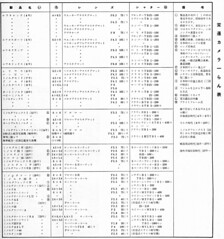
|
| Chronology in Shashin Kōgyō September 1958. (Image rights) |
- Minolta Camera. 35-nen no ayumi (三十五年のあゆみ, 35-year history). November 1963. (This book does not mention the military TLR.)
- Minolta Camera. 45-nen no ayumi (45年のあゆみ, 45-year history). October 1973. P.89.
- Minolta Camera. Minolta 50-nen no ayumi (Minolta・50年のあゆみ, Minolta 50-year history). November 1978. Pp.6–7 and 65.
- Shashin Kōgyō no.77 (September 1958). "Hensen kamera ichiran-pyō" (変遷カメラ一らん表, Table of camera evolution.) P.295. (This is a chronology of Minolta cameras from the Nifcarette onwards. This document is reproduced in this Flickr page by Rebollo_fr.)
Recent sources
- Asahi Camera (アサヒカメラ) editorial staff. Shōwa 10–40nen kōkoku ni miru kokusan kamera no rekishi (昭和10–40年広告にみる国産カメラの歴史, Japanese camera history as seen in advertisements, 1935–1965). Tokyo: Asahi Shinbunsha, 1994. ISBN 4-02-330312-7. Item 921.
- Awano Mikio (粟野幹男). "Minorutafurekkusu Ōtomatto Shisakuki" (ミノルタフレックスオートマット試作機, Minoltaflex Automat prototypes). In Camera Collectors' News no.254 (August 1998). Nishinomiya: Camera Collectors News-sha.
- Awano Mikio (粟野幹男). "Senzen no Minoruta kamera" (戦前のミノルタカメラ, Prewar Minolta cameras). Kamera Rebyū: Kurashikku Kamera Senka (カメラレビュー クラシックカメラ専科) / Camera Review: All about Historical Cameras no.12, October 1988. No ISBN number. Minoruta kamera no subete (ミノルタカメラのすべて, special issue on Minolta). Pp.13–7. (Shows a picture of the "type B" and "type C" side by side with a regular Automat.)
- Awano Mikio (粟野幹男). "Mezurashii nanbā-shū" (珍らしいナンバー集, Anthology of rare numbers). In Camera Collectors' News no.15 (September 1978). Nishinomiya: Camera Collectors News-sha. Pp.13–7. (Shows pictures of a "type C".)
- Francesch, Dominique and Jean-Paul. Histoire de l'appareil photographique Minolta de 1929 à 1985. Paris: Dessain et Tolra, 1985. ISBN 2-249-27685-4. Pp.27 and 88–9.
- Mieno Tsuguharu (三重野二治). "Watashi no Minorutafurekkusu ni tsuite" (私のミノルタフレックスについて, About my Minoltaflex) and answer by Awano Mikio (粟野幹男). In Camera Collectors' News no.26 (August 1979). Nishinomiya: Camera Collectors News-sha. Pp.5–9.
- "Minolta Camera: Shisaku kamera" (Minolta Camera: 試作カメラ, Prototype cameras). Kamera Rebyū: Kurashikku Kamera Senka (カメラレビュー クラシックカメラ専科) / Camera Review: All about Historical Cameras no.12, October 1988. No ISBN number. Minoruta kamera no subete (ミノルタカメラのすべて, special issue on Minolta). Pp.60–1.
- "Minoruta no gun'yō kamera" (ミノルタの軍用カメラ, Minolta military cameras). Kamera Rebyū: Kurashikku Kamera Senka (カメラレビュー クラシックカメラ専科) / Camera Review: All about Historical Cameras no.12, October 1988. No ISBN number. Minoruta kamera no subete (ミノルタカメラのすべて, special issue on Minolta). P.18.
- Saeki Kakugorō (佐伯恪五郎). "Tashima Gizō-shi ni kiku" (田嶋義三氏に聞く, "Asking Tashima Gizō"). Kamera Rebyū: Kurashikku Kamera Senka (カメラレビュー クラシックカメラ専科) / Camera Review: All about Historical Cameras no.12, October 1988. No ISBN number. Minoruta kamera no subete (ミノルタカメラのすべて, special issue on Minolta). Pp.76–9.
- Scheibel, Anni Rita and Joseph. 70 Jahre Minolta Kameratechnik — Von der Nifcalette bis zur Dynax 9. Stuttgart: Lindemanns Verlag, 3rd edition, 1999. ISBN 3-89506-191-3. P.29.
- Sugiyama, Kōichi (杉山浩一); Naoi, Hiroaki (直井浩明); Bullock, John R. The Collector's Guide to Japanese Cameras. 国産カメラ図鑑 (Kokusan kamera zukan). Tokyo: Asahi Sonorama, 1985. ISBN 4-257-03187-5. Items 2015–6.
- Tanaka Masao (田中政雄). "Minolta Camera: nigan-refu kamera" (Minolta Camera: 二眼レフカメラ, Minolta TLR cameras). Kamera Rebyū: Kurashikku Kamera Senka (カメラレビュー クラシックカメラ専科) / Camera Review: All about Historical Cameras no.12, October 1988. No ISBN number. Minoruta kamera no subete (ミノルタカメラのすべて, special issue on Minolta). Pp.25–30.
| Nifca, Molta and Chiyoda prewar and wartime cameras () | |
|---|---|
| folding plate cameras | |
| Nifcaklapp | Nifcasport | Sirius | Arcadia | Lomax | Eaton | Happy | |
| folding rollfilm cameras | telescopic bakelite cameras |
| Nifcarette | Sirius Bebe | Semi Minolta | Auto Semi Minolta | Minolta Vest | Baby Minolta | Minolta Six |
| strut-folding cameras | TLR cameras |
| Nifca-Dox | Minolta | Auto Minolta | Auto Press Minolta | Minoltaflex | Minoltaflex Automat | Minoltaflex military prototype |
